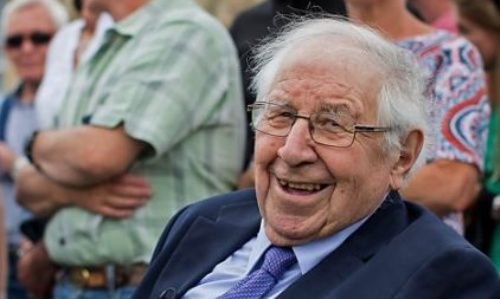Henry Sandon MBE (1939-1943)

Henry George Sandon (née Sandoni) was born in London in 1928. Ceramics were never a feature of his childhood, though his parents, like him, had their passions. His mother, Clara, was a boxing enthusiast and regularly stole to bars in the city to heckle at the fighters.
His father, Augusto, was an eccentric Italian who trained dogs for the cinema. As a boy Sandon starred in one of his father’s films as an urchin who was kidnapped and rescued by a dog, and he often assisted on set.
He inherited his father’s love of the pictures, frequently skipping school to sit in wide-eyed wonder at the cinema until an usher shone a light in his face or a sign appeared on the screen asking about his whereabouts.
After the outbreak of the Second World War, he was evacuated to High Wycombe, where he was educated at the RGS. He enjoyed acting in school plays and later said that this dramatic training was integral to his performance on Antiques Roadshow.
Music was Sandon’s first true love. It ran in the family; his grandfather ran a theatre orchestra and played piano in silent feature films. Sandon was eager to pursue his own career in music, and after joining the South East Command Concert Party as the resident baritone he won a scholarship to study at the Guildhall School of Music.
He tried his hand at insurance - which he found exceedingly boring - and spent a brief spell as a traffic warden - which induced panic too often for his liking.
Sandon moved to Worcester in 1953 to be close to the cathedral choir, which he duly joined as a lay clerk. He also became music master at the Royal Grammar School, and sang under the baton of Ralph Vaughan Williams.
His obsession was sparked when he dug up some Roman artefacts in his back garden at the age of 29. He was teaching music and singing in the cathedral choir in Worcester at the time, but the spiritual awakening he experienced on hauling up a medieval jug from the bottom of a well was so blinding that he soon ditched his budding career in music, rolled up his sleeves and dedicated his life to becoming one of the world’s leading experts on Worcester porcelain.
Once established as a ceramics expert, Sandon began giving lectures at luncheons in the north of England. He was always rewarded with a good lunch. “That is probably why I’m the shape I am,” he said. “A bit like a pot!”
In 1966, he was elected curator of the Dyson Perrins Museum of Porcelain (later the Museum of Royal Worcester), at the age of 38. It was an old-fashioned establishment and the veteran archeologists were cagey about their craft, but Sandon soon made his mark excavating the previously untouched Worcester factory site.
What he discovered changed the narrative around Worcester porcelain. “I delved into the history, found it was poorly documented and set about researching for another history.” He made the same mark excavating factories in Shropshire and Bristol.
Sandon wrote seven books on porcelain, two of them with John, who is a ceramics and glass expert. He was appointed MBE in 2008 for services to broadcasting, to the ceramics industry and to charity.
When the avuncular Sandon joined Antiques Roadshow in 1979 the programme surged in popularity so much that he became the unwilling recipient of a sort of celebrity. “It can be a bit embarrassing,” he said. “We did a show in Toronto recently where there was a separate queue for people who wanted to kiss me!”
He was a charming figure who elicited and clarified information through gentle interrogation, complete with his warm, toothy grin. “You can always say something nice. I might say, ‘It’s not worth much, dear, but put it away for 100 years, and it will be’. Or I can praise the bag it came in. I always believe that if they enjoy the thing, it doesn’t matter whether it’s worth 10p or £10 million.”
In nearly 40 years of appearances on Antiques Roadshow, there was one item that stuck with Sandon. Ozzy the Owl was taken to the table in 1990, having been used by its owner as a flower vase. It was identified by Sandon, with characteristic excitement, as a rare piece of Staffordshire. After the shocked owner spluttered “I brought it here on the bus”, Sandon advised: “Take it home by taxi, accompanied by two policemen.”
Later Ozzy was bought for nearly £30,000 by Stoke-on-Trent city museum. For Sandon’s 80th birthday he was presented with a cake in the shape of the owl, as a reminder of the episode.
He was sure that such treasured possessions would have pride of place in his afterlife. “They are God-given. I shall take one to heaven,” he said. “It would be awful to get there and find they use hotel porcelain or plastic pots.”
Henry Sandon MBE, antiques expert and broadcaster, was born on 10 August, 1928. He died on 25 December, 2023, aged 95.